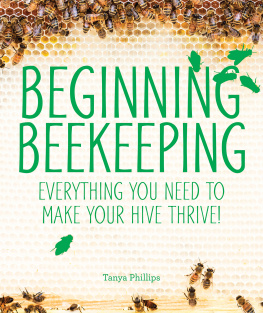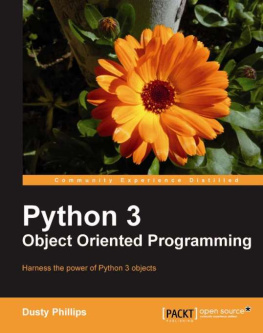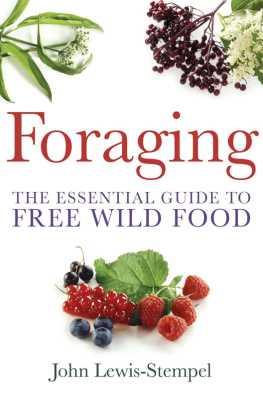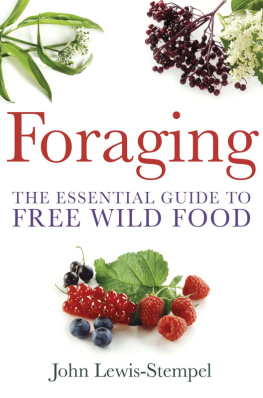

For Eloise, Ebony, Emile and Ruby

Introduction
The purpose of this book is twofold: firstly I want to illustrate the incredible diversity of foods that can be discovered in nature, and secondly, I want to inspire and encourage innovation in cooking and preparing these delicacies once they have been located.
The Plants
I have given the reader as much information as possible about the edible plants and mushrooms that can be found in the wild, with photographs and details of habitat, time of flowering or fruiting, and I have also included some details about which garden flowers can be eaten and enjoyed.
The Recipes
These fall into two categories: the traditional folk recipes that I have gathered together over years of research, and these are presented as standard recipe text, and secondly my own thoughts and ideas for dealing with the plants in an imaginative, often visually stimulating way. The text and pictures are designed to inspire the reader into inventing or abridging recipes themselves, to suit the family and guests who sit down to enjoy the dishes prepared from the bounty of the countryside.
How the Book is Ordered
All the information in this book is organized into six sections based on different types of plants and uses. I kick off with my favourites Mushrooms. This is the biggest as I have been collecting and cooking mushrooms for decades; however, it is a section fraught with danger. Next I deal with Salads. Years ago I worked with an inspirational gardener/cook, Joy Larkcom, on her Salad Book, and from this I developed a fascination for using flowers to decorate and titillate my salads. This section includes not only the wild flowers that are great to eat but some of the garden varieties that can turn an ordinary bowl of lettuce into an exciting extravaganza. The third section is Seaweeds. This is another group of plants that I am passionate about. We are an island nation surrounded by sea brimming with seaweeds of all types; why do we not make use of this amazing resource the way the Japanese do? The fourth section deals with Vegetables and Herbs; the fifth reflects the later seasons of the year: it covers Berries, Fruit and Nuts; finally there is a section devoted to preparing drinks, ranging from Teas, to Beers and Wines, and Cordials.

The recipes have been gleaned from a variety of sources. Historical research into old herbals and cookery books revealed an enormous number of ideas about how to cook wild plants, many far too elaborate and impracticable for modern cooks, but nevertheless fascinating reading. I am also indebted to numerous contemporary authors and magazines for recipes I have either quoted verbatim or adapted slightly to suit my ingredients; and last, but by no means least, I have regularly invaded the kitchens of friends and acquaintances to steal their cherished secrets.
Mushroom Collecting
This book does not set out to be a field guide to the identification of edible mushrooms. There are in the region of 2000 mushrooms that may be found in Europe, including deadly poisonous and edible species. Before actually considering eating any wild mushrooms you must be sure of your identification; for this you will need a specialist book and/or the help of an expert (see ). However, if you persevere and conquer the identification problems, you will find cooking and eating wild mushrooms opens up many new, exciting and rewarding culinary areas to explore.
Seaweeds
The seaweeds must be, without doubt, the most wasted of our natural resources. In the past a few species have been eaten but generally speaking the habit has died out, although laver in Wales and carragheen in Ireland are still consumed in some quantity. Perhaps the reason why the edible seaweeds have disappeared from our tables is because the standard ways of cooking them emerged out of necessity and poverty, rather than from choice and taste. Seaweeds are among the most nutritious plants that can be found, as they contain high proportions of vitamins, proteins and minerals. Vitamins A, B1, B12, C and D are contained in large quantities in many types of seaweed. Sea lettuce, for instance, has more of the growth vitamin, vitamin A, than butter and many of the green seaweeds contain a higher concentration of vitamin B12 than can be found in liver. In addition to vitamins all species of seaweed are rich in minerals and trace elements because sea water has almost exactly the same proportion of minerals as human blood.
Collection and Conservation
It is my firm belief that increased knowledge and interest in the flora of our countryside will lead to greater personal thought about how wild plants may be best protected and encouraged. This statement might seem to be at odds with a book about the collection and consumption of wild plants, fruits and roots, but man cannot live without eating, and I have only included recipes for plants which are in no danger of extinction. It is a fact that the greatest threat to the continuing destruction of our wild flora is caused by loss of habitat, due to building, road-making, draining and spraying. Careful collection of wild plants is not of itself an ecological menace.
I would like to emphasize again to the prospective wild food hunter that only plants which are growing in profusion should be harvested and then only in such quantities that the viability of each colony will not be endangered.
Please remember that all plants are now protected under the law. It is illegal to uproot any plant without the permission of the landowner.
SECTION ONE
MUSHROOMS
Mushrooms and their relatives found growing on wood, or indeed underground, are the most exciting and diverse of our wild food resources. Compared with vegetables and herbs they are generally more nutritious and have an astounding array of different forms, textures, smells and flavours. But, and this cannot be over emphasized, they are dangerous. There are many toxic ones: some tasting awful, some nice tasting that can cause serious gastric upset and of course there are those that can kill you. The rule has to be, if you are at all unsure, dont! Those who have suffered by eating poisonous mushrooms have tended to be people who have gone at it rather bull-headedly sure that they knew what was what. Take no risks. Only have a go if you have thoroughly learnt about all the poisonous and edible species or if you have had your collections checked by a totally reliable expert.
Once you are sure of identification you can enjoy an amazing array of mushrooms, from the sexy underground truffles to the woodland mushrooms like the Italians favourite, porcini (ceps), and the German favourite, chanterelles, via the wood-growing langue de boeuf, pleurote (a chefs favourite) to chicken of the woods fungi that can be found on our common oak and beech trees.
Next page






















